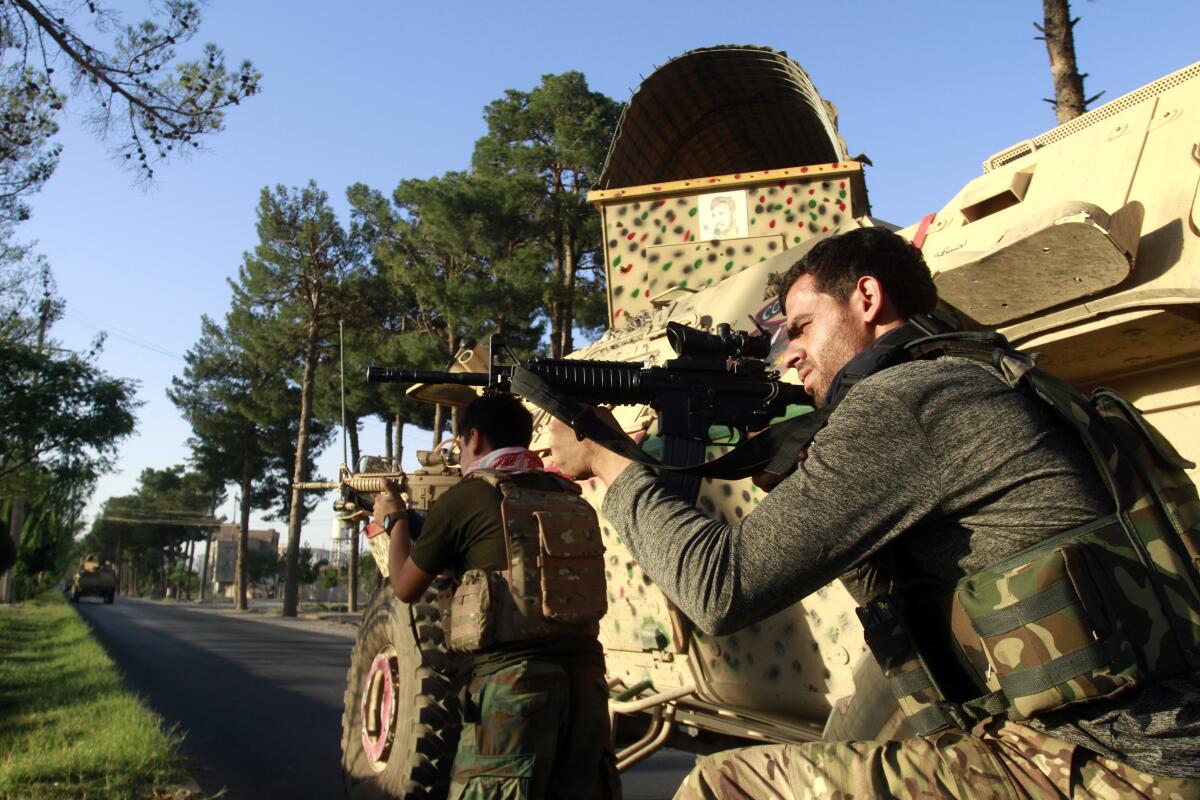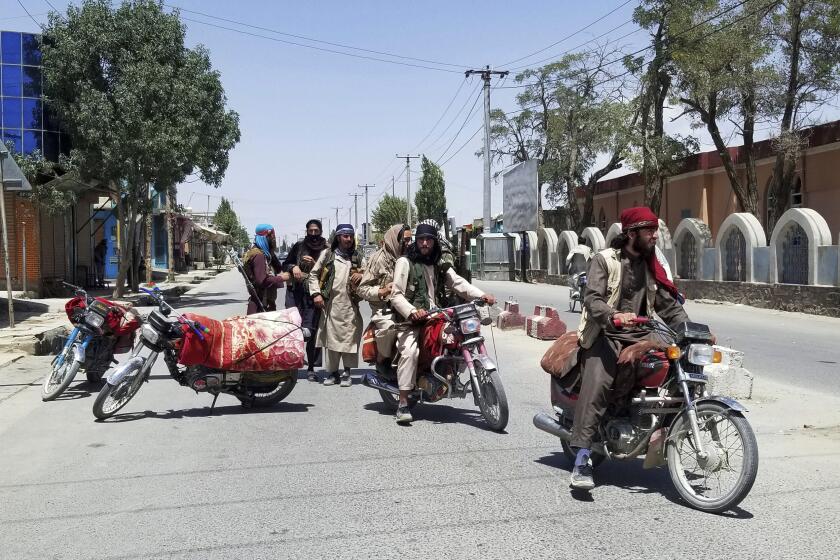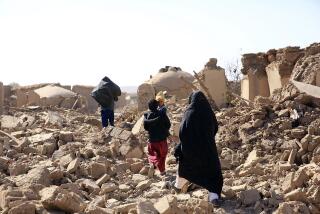Fall of Afghan jewel a harbinger of a return to dark times

- Share via
Over the years, despite everything, Herat had the feel of a sanctuary.
Now, with the Taliban claiming its capture, Afghanistan’s third-largest city is among the insurgents’ biggest prizes in a cataclysmic weeklong onslaught — one that has seen the fall or near-fall of more than a dozen provincial capitals, including Kandahar, the militant group’s birthplace.
Through both location and history, Herat offers a crucial window into the long arc of Afghanistan’s struggle. Situated at an ancient Silk Road crossroads near the border with what is now Iran, it is western Afghanistan’s commercial capital, home to more than half a million people.
In its ancient incarnations, the city saw centuries of conquest and upheaval. Modern-day Herat suffered in the Soviet era, endured the lash of Taliban rule and was not immune to bloodletting during the two-decade American-led military presence, triggered by the terrorist attacks of Sept. 11, 2001, that is now in its final weeks.
Yet nearly alone among Afghan provincial cities, Herat in recent years had often seemed poised on the cusp of modernity and success.
A center of medieval learning in mathematics and astronomy, the city is home to a university and an educated middle class. Once a saffron-scented cultural treasure house, present-day Herat still looks proudly to its rich heritage of Persian poetry, miniaturist painting and resplendent architecture.
And for a generation of Afghan women and girls, the onetime desert garden was an oasis. The capital, Kabul, is 400 miles to the east, too far away to wield much gravitational pull, but Herat was far more progressive than other remote provincial hubs.
With girls’ education and women’s work outside the home an accepted mainstay of so many Heratis’ lives, a Taliban takeover means being nightmarishly dragged back in time. By day’s end, though, the militant group’s victory appeared sealed.
A Taliban spokesman, Qari Yousef Ahmadi, claimed the Herat governor’s office was in the insurgents’ hands, and the group disseminated a video showing fighters inside what it said was the city police headquarters. Ahmadi boasted that government forces had largely fled or surrendered.
As the Taliban seize more of Afghanistan, the Biden administration is sending troops to the Kabul airport to help move U.S. Embassy staff and other Americans.
That was in itself a stark departure. Long before the onslaught, Herat had again and again proved its resistance bona fides.
In 1979, the city was the staging ground for an uprising against Afghanistan’s Moscow-backed communist government. In response to the killing of scores of Soviet advisors, Soviet warplanes carried out reprisal bombing runs that killed up to 20,000 people in and near the city.
When the Taliban movement came to power in 1995, Herat-based militia leader Ismail Khan, a veteran of the anti-Soviet fight, harried the new rulers, sometimes inflicting painful blows. But after a key ally went to the Taliban side, Khan and his fighters were forced to find sanctuary in Iran.
Captured by the Taliban after returning to lead an unsuccessful uprising, Khan spent two years in prison in Kandahar before escaping, while his home city chafed under the militant group’s harsh rule. In 2001, he fought alongside U.S.-led forces to help rout the Taliban.
As Herat came under Taliban siege weeks ago, the grizzled warlord, now 75, vowed to prevent it from being overrun — although by then, the Taliban had already seized a key crossing between Iran and Afghanistan and appeared undeterred by airstrikes.
“We will soon go to the front lines, and with the help of God change the situation,” Khan told reporters in Herat in July. The situation did change — but not to his or the city’s advantage.
Afghan journalist Bilal Sarwary wrote Thursday on Twitter that he had been in frequent communication with terrified city residents, including a shopkeeper called Haji Abdul Hamid.
“People are scared. There is fear. There is chaos in the city,” Abdul Hamid told him. The shopkeeper said he managed to get his family out, but left behind his home and business, fleeing only with some cash and clothing.
With nightfall, celebratory gunfire from the insurgents rang out in city streets, and reports said Khan’s personal residence had been seized. The warlord’s whereabouts were not immediately known, but the city’s fate offered proof that even a powerful, well-armed patron, whose involvement had been decisive in previous battles, could provide little protection.
The Taliban’s swift overrunning of much of Afghanistan — by Thursday its fighters had seized or menaced more than a dozen provincial capitals, including Ghazni, on the main road linking Kabul to the country’s south — spurred the U.S. administration to action.
President Biden, who has said repeatedly in recent days that Afghans must fight their own battles, announced that the United States would dispatch thousands of military personnel to Afghanistan — not to aid in any offensive, but to provide security as U.S. civilians were airlifted from the embassy.
For some, the presumed fall of Herat was a bitter reminder of a hopeful moment in the conflict — when restorers a decade ago unveiled a painstaking and partially U.S.-funded reconstruction of the city’s historic citadel, an imposing assortment of towers and battlements originally built between the 13th and 15th centuries.
Then-U.S. Ambassador Ryan Crockett was on hand for the occasion and hailed it as a symbol of what could be better times to come.
“As this citadel represents, Afghanistan stood as a great nation,” the American envoy said that day in 2011. “It will so stand again.”
More to Read
Sign up for Essential California
The most important California stories and recommendations in your inbox every morning.
You may occasionally receive promotional content from the Los Angeles Times.











